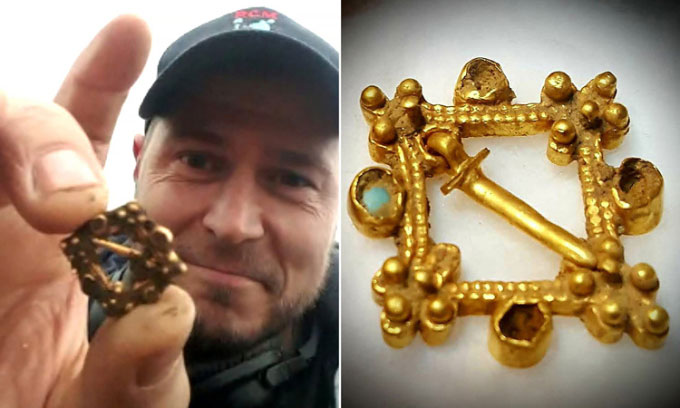A gold brooch with a sword-shaped pin likely belonged to a noble associated with the military.
Metal detectorist David Edwards discovered a gold brooch adorned with emeralds buried in a farmland area near his home in Cardigan, western Wales, as reported by Mail on December 15. The brooch dates back to around the 13th century, measures less than 2.5 cm wide, and weighs 4 grams. It is a type of brooch known as a “trophy” shape, likely belonging to a high-ranking noble such as a duke or an earl.

David Edwards and the emerald-studded gold brooch. (Photo: David Edwards/BNPS).
Edwards was astonished to find the ancient brooch while metal detecting after work. He went to the farmland near his home and had only an hour to search before it got dark. Edwards did not expect to find anything valuable.
However, after 30 minutes, the metal detector emitted a signal. When he dug down about 10 cm, Edwards saw the brooch with the sword-shaped pin delicately buried in the mud. “I couldn’t believe the little pin was still intact. I didn’t dare clean it right there because it looked very fragile, so I took the brooch home, gently washed it, and the green emerald revealed itself,” he recounted.
“I had seen silver brooches with similar designs, which are already rare. But I had never encountered anything like this. Finding a gold item with such a beautiful emerald is truly special. There are four trophy shapes (decorative details resembling miniature trophies), and they might all contain gems,” Edwards added.
“This is an extremely impressive piece of jewelry, and I am certain the wearer was a duke or an earl, perhaps also connected to the military due to the sword-shaped pin. It would have been illegal for lower classes to wear such fine gold,” said Julian Evan-Hart, an expert in rare treasures and editor of the magazine Treasure Hunting.
Evan-Hart could not determine the exact value of the gold brooch as nothing similar has been released to the market for comparison. He estimated the minimum selling price to be £10,000, but it could also reach up to £100,000.
The brooch is currently being processed under the UK Treasure Act of 1996. Investigators will decide whether the finder must sell it to a museum at a price determined at auction or if he can keep the artifact. However, any money Edwards earns will have to be shared with the owner of the farmland.


















































